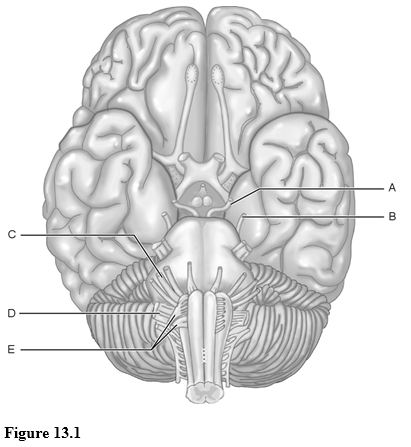When the receptor potential of the baroreceptors decreases, the cardiovascular center responds by bringing about an increase in
a. stroke volume
b. venous return
c. total peripheral resistance
d. all of the above
e. only a and b
D
You might also like to view...
Cerebrospinal fluid is formed by the
A. septum pellucidum. B. arachnoid granulation. C. arachnoid villi. D. mesencephalic aqueduct. E. choroid plexus.
Which of the following is incorrect pertaining to the portal vein?
A) It is typically formed by the superior mesenteric and splenic veins posterior to the neck of the pancreas. B) It carries more of the total blood volume reaching the liver than any other vessel. C) It is typically the most anterior of the structures within the hepatoduodenal ligament. D) It divides into right and left branches at the porta hepatis. E) It may spread cancer to the liver.
Using Figure 13.1, match the following:

1) Innervates the superior oblique muscle.
2) Longest cranial nerve.
3) Damage to this nerve would cause dizziness, nausea, and loss of balance.
4) Involved in movement of the digestive tract.
5) Damage to this nerve would cause difficulty in speech and swallowing, but no effect on visceral organs.
6) Damage to this nerve would keep the eye from rotating inferolaterally.
Match the chemical signal with the appropriate description.A. Chemicals produced by neurons that function as hormonesB. Chemicals that act locally on nearby cellsC. Chemical secreted by presynaptic terminalD. Influences same cell type from which it is secretedE. Chemical secreted into blood by specialized cells; travels some distance to target tissuesNeurotransmitter
Fill in the blank(s) with the appropriate word(s).